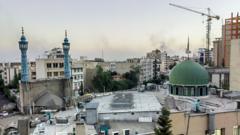This article explores the remnants of U.S. involvement in Vietnam through the lens of history and memory, with a focus on significant locations in Ho Chi Minh City.
Vietnam's Evolution: Reflecting on the End of the American Presence 50 Years On

Vietnam's Evolution: Reflecting on the End of the American Presence 50 Years On
A look back at the chaotic flight of Americans from Vietnam, captured in the buildings left behind.
On April 29, 2025, reflecting on the dramatic escape from Vietnam exactly 50 years prior, the once quiet rooftop of the Pittman apartment building in Ho Chi Minh City tells gripping tales of chaos and desperation. It was here, amid structural simplicity that lacked architectural grandeur, that crucial moments of the Vietnam War played out beneath the watchful eyes of local residents, such as Nguyen Van Hiep.
As the South Vietnamese government crumbled, Hiep vividly remembers the scene surrounding an American helicopter landing on that rooftop. “It was chaotic,” he recalls, “with Vietnamese civilians clamoring to be evacuated.” The helicopter, part of a frantic evacuation effort, was barely accommodated by the building’s elevator shaft. American personnel, including one in a white dress shirt, attempted to maintain some semblance of order as people rushed to secure their escape.
The imagery of that afternoon became iconic—yet notably misunderstood—after a photograph by Hubert Van Es was circulated with an incorrect caption, misrepresenting the location and context. These moments were not merely historical footnotes but pivotal instances that shaped the narrative of the Vietnam War, evolving the understanding of the U.S. withdrawal.
Visitors today encounter the buildings that housed American officers and diplomats, juxtaposed against the backdrop of a modern metropolis. Each structure resonates with the history of a nation transformed since the fall of Saigon, reflecting both the scars and resilience of its people. As onlookers examine the remnants of this past, they engage in a conversation about memory, identity, and progress—a dialogue that remains vital in shaping the contemporary landscape of Vietnam.
In the heart of Ho Chi Minh City, the stories embedded in its architecture serve as a constant reminder of the sacrifices made and the resilience displayed, providing a lens to view a transformed nation while honoring the truths lost to time.
As the South Vietnamese government crumbled, Hiep vividly remembers the scene surrounding an American helicopter landing on that rooftop. “It was chaotic,” he recalls, “with Vietnamese civilians clamoring to be evacuated.” The helicopter, part of a frantic evacuation effort, was barely accommodated by the building’s elevator shaft. American personnel, including one in a white dress shirt, attempted to maintain some semblance of order as people rushed to secure their escape.
The imagery of that afternoon became iconic—yet notably misunderstood—after a photograph by Hubert Van Es was circulated with an incorrect caption, misrepresenting the location and context. These moments were not merely historical footnotes but pivotal instances that shaped the narrative of the Vietnam War, evolving the understanding of the U.S. withdrawal.
Visitors today encounter the buildings that housed American officers and diplomats, juxtaposed against the backdrop of a modern metropolis. Each structure resonates with the history of a nation transformed since the fall of Saigon, reflecting both the scars and resilience of its people. As onlookers examine the remnants of this past, they engage in a conversation about memory, identity, and progress—a dialogue that remains vital in shaping the contemporary landscape of Vietnam.
In the heart of Ho Chi Minh City, the stories embedded in its architecture serve as a constant reminder of the sacrifices made and the resilience displayed, providing a lens to view a transformed nation while honoring the truths lost to time.






















